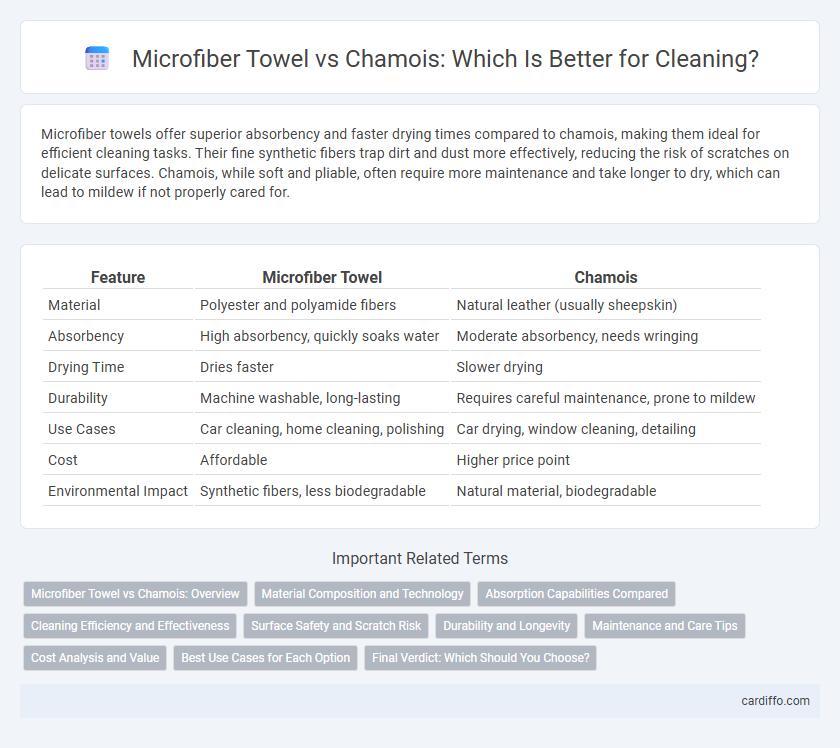Microfiber towels offer superior absorbency and faster drying times compared to chamois, making them ideal for efficient cleaning tasks. Their fine synthetic fibers trap dirt and dust more effectively, reducing the risk of scratches on delicate surfaces. Chamois, while soft and pliable, often require more maintenance and take longer to dry, which can lead to mildew if not properly cared for.
Table of Comparison
| Feature | Microfiber Towel | Chamois |
|---|---|---|
| Material | Polyester and polyamide fibers | Natural leather (usually sheepskin) |
| Absorbency | High absorbency, quickly soaks water | Moderate absorbency, needs wringing |
| Drying Time | Dries faster | Slower drying |
| Durability | Machine washable, long-lasting | Requires careful maintenance, prone to mildew |
| Use Cases | Car cleaning, home cleaning, polishing | Car drying, window cleaning, detailing |
| Cost | Affordable | Higher price point |
| Environmental Impact | Synthetic fibers, less biodegradable | Natural material, biodegradable |
Microfiber Towel vs Chamois: Overview
Microfiber towels feature densely woven synthetic fibers that provide superior absorbency and quick-drying properties compared to traditional chamois, which are made from natural sheepskin known for its softness and high water absorption. Microfiber towels excel in trapping dirt and dust with electrostatic properties, making them ideal for delicate surfaces and streak-free cleaning, whereas chamois towels are preferred for heavy-duty water removal and polishing tasks. The durability and ease of maintenance of microfiber towels, including machine washability and resistance to odors, offer practical advantages over the delicate and more labor-intensive care required for chamois.
Material Composition and Technology
Microfiber towels consist of ultra-fine synthetic fibers, typically a blend of polyester and polyamide, engineered for superior absorption and dirt trapping through capillary action. Chamois is made from natural leather, primarily from sheepskin, renowned for its soft texture and high absorbency due to its open pore structure. Advanced microfiber technology enhances durability and quick-drying properties, while chamois relies on natural softness and flexibility for gentle cleaning.
Absorption Capabilities Compared
Microfiber towels exhibit superior absorption capabilities compared to chamois, as they can hold up to seven times their weight in water due to their dense fiber structure. These towels quickly wick moisture away from surfaces, making them ideal for drying cars, windows, and delicate items without leaving streaks. Chamois, while effective, absorb less liquid and often require more frequent wringing, reducing efficiency in rapid drying tasks.
Cleaning Efficiency and Effectiveness
Microfiber towels offer superior cleaning efficiency compared to chamois due to their dense fiber structure, which traps dirt, dust, and moisture more effectively without scratching surfaces. Chamois excels in water absorption and streak-free drying, but often requires more effort and maintenance to prevent odor and wear. For high-performance cleaning, microfiber towels deliver durability and versatility with consistent results on various surfaces.
Surface Safety and Scratch Risk
Microfiber towels offer superior surface safety due to their ultra-fine synthetic fibers that effectively trap dirt without abrasive friction, significantly reducing scratch risk on delicate surfaces like automotive paint and glass. Chamois, being natural leather, is highly absorbent but can accumulate grit particles that may cause micro-scratches during cleaning. For scratch-sensitive tasks, microfiber towels provide a safer option, combining gentle texture with efficient dirt lift to preserve surface integrity.
Durability and Longevity
Microfiber towels offer superior durability and longevity compared to chamois, as they withstand frequent washing without losing absorbency or texture. Chamois, while gentle and effective for drying, tend to degrade faster with regular use and exposure to oils or dirt. Investing in high-quality microfiber ensures extended usability and consistent cleaning performance over time.
Maintenance and Care Tips
Microfiber towels require regular washing in cold or warm water without fabric softeners to maintain their absorbency and softness, while chamois cloths should be rinsed thoroughly after each use and air-dried flat to prevent mildew and stiffening. Avoid using bleach on both materials to preserve fibers and extend lifespan. Store microfiber towels loosely folded in a clean, dry environment, and keep chamois cloths lightly oiled with a special leather conditioner to maintain flexibility and water absorption.
Cost Analysis and Value
Microfiber towels offer a cost-effective solution for cleaning due to their durability and reusability, often lasting hundreds of washes without losing effectiveness, making initial investment economical over time. Chamois, while providing superior absorbency and softness, generally come with a higher upfront cost and require more maintenance, which can increase overall expenses. Evaluating long-term value, microfiber towels tend to deliver better cost efficiency for regular cleaning tasks, whereas chamois may justify their higher price in specialized applications requiring gentle handling.
Best Use Cases for Each Option
Microfiber towels excel in cleaning delicate surfaces such as glass, car exteriors, and electronics due to their ultra-fine fibers that trap dirt and absorb moisture efficiently. Chamois leather towels are ideal for drying vehicles and boats, providing streak-free finishes and superior water absorption without scratching paintwork. Both materials offer unique advantages: microfiber for detailed cleaning and chamois for heavy-duty drying tasks.
Final Verdict: Which Should You Choose?
Microfiber towels provide superior absorbency and quick-drying properties, making them ideal for everyday cleaning tasks and delicate surfaces. Chamois towels excel in streak-free drying and gentle polishing, particularly for automotive and glass applications. Choose microfiber for versatile, efficient cleaning and chamois for specialized drying and finishing needs.
Microfiber towel vs Chamois Infographic

 cardiffo.com
cardiffo.com